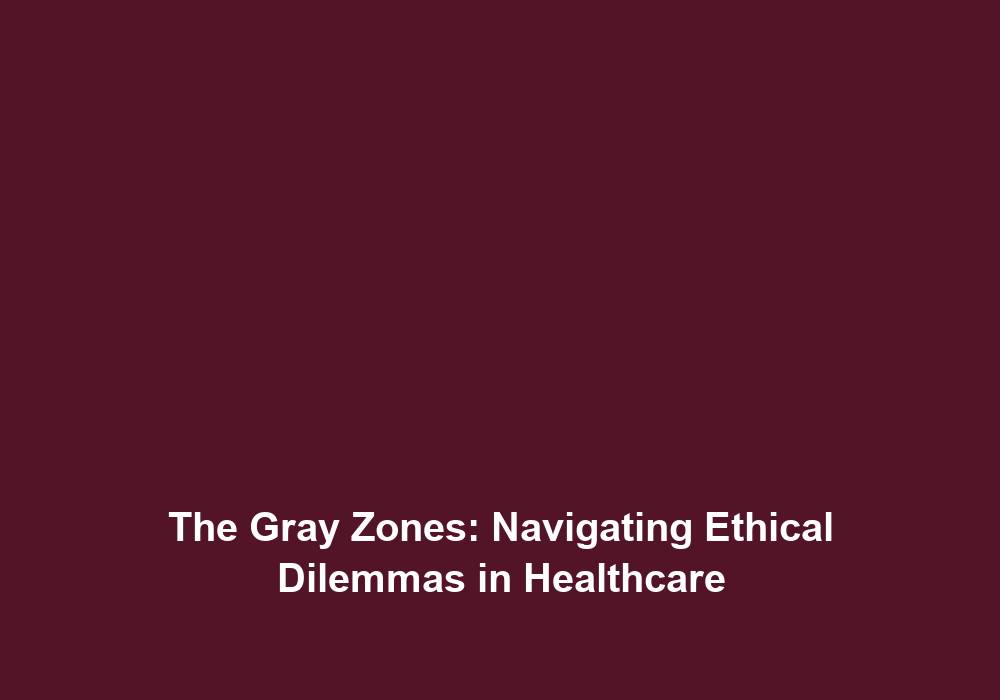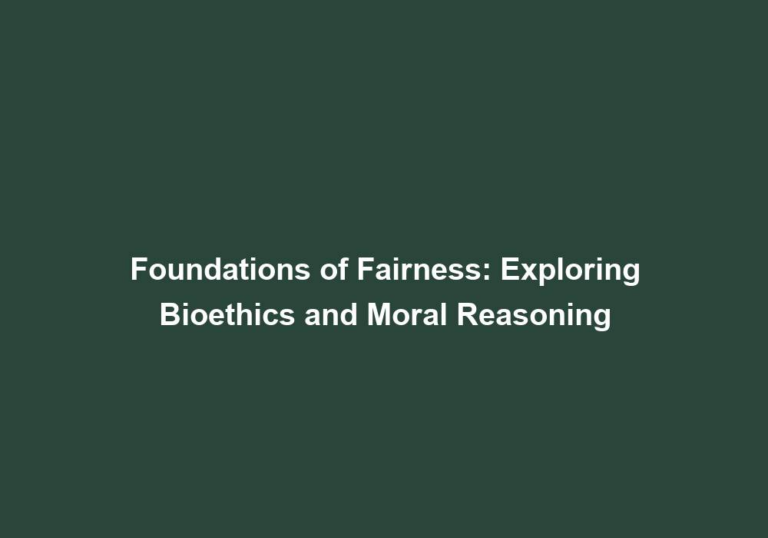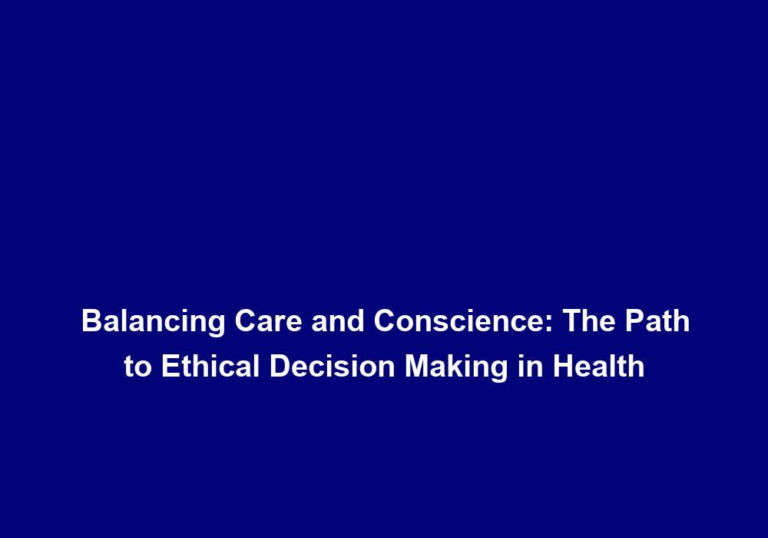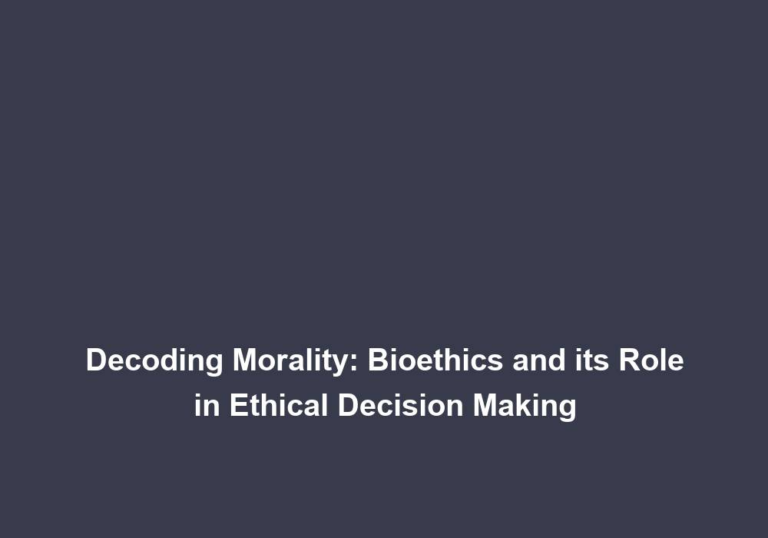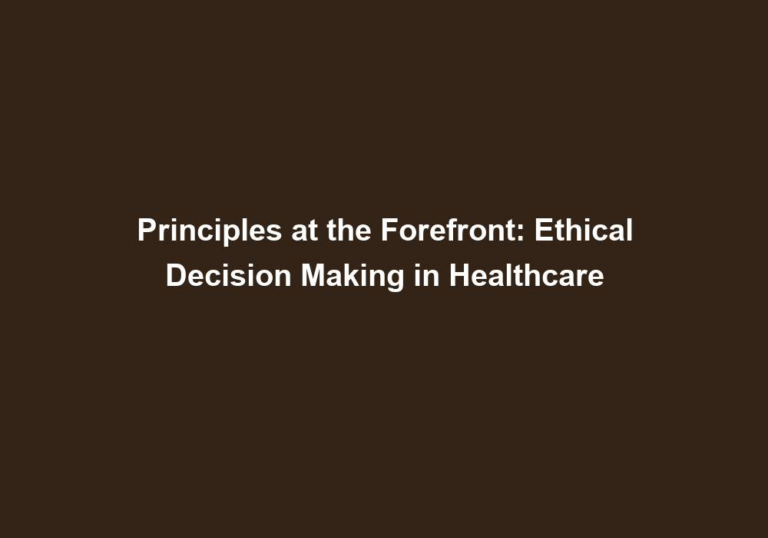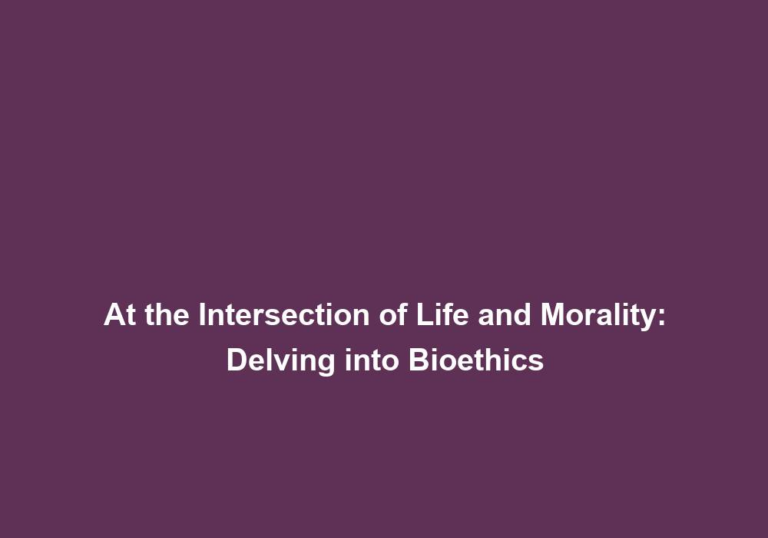The Gray Zones: Navigating Ethical Dilemmas in Healthcare
Ethical dilemmas often arise in the healthcare industry, presenting complex challenges for professionals and patients alike. These gray areas can be difficult to navigate, as they require careful consideration of moral, legal, and practical factors. In this article, we will explore some common ethical dilemmas in healthcare and offer insights on how to address them.
Introduction to Ethical Dilemmas in Healthcare
Healthcare professionals are entrusted with the responsibility of providing the best possible care for their patients while adhering to ethical principles. However, there are situations where conflicting values, limited resources, or uncertain outcomes create moral dilemmas. These gray zones can test the integrity and decision-making capabilities of healthcare providers.
In order to effectively navigate these ethical dilemmas, healthcare professionals must have a solid understanding of the principles that guide ethical decision-making. This includes principles such as beneficence (doing good), autonomy (respecting patient choices), justice (fairness in resource allocation), and nonmaleficence (preventing harm). By considering these principles and the unique circumstances of each situation, healthcare professionals can make informed decisions that prioritize patient well-being while upholding ethical standards.
Ethical Dilemma 1: Allocation of Limited Resources
One of the most challenging ethical dilemmas in healthcare is the allocation of limited resources, such as organs for transplantation or life-saving medications during a pandemic. The scarcity of these resources forces healthcare professionals to make difficult decisions regarding who receives them.
To address this dilemma, healthcare organizations should develop transparent and fair allocation criteria based on medical need, urgency, and potential benefit. These criteria should be communicated effectively to patients, families, and the public to ensure accountability and reduce conflicts. Additionally, healthcare professionals should engage in ongoing discussions and collaborations with ethicists, policymakers, and the community to refine and update these criteria as necessary. By involving multiple stakeholders in the decision-making process, healthcare professionals can ensure that resource allocation is as fair and equitable as possible.
Some strategies that can be implemented to navigate the allocation of limited resources include:
- Developing a comprehensive and standardized assessment process that takes into account the severity of the patient’s condition, the likelihood of success of the intervention, and the potential impact on overall public health.
- Establishing an interdisciplinary committee or task force that includes medical professionals, ethicists, and community representatives to review and make decisions regarding resource allocation.
- Regularly reviewing and updating allocation policies and criteria based on emerging evidence, ethical considerations, and community input.
By implementing these strategies, healthcare professionals can mitigate the ethical dilemmas associated with resource allocation and ensure that decisions are made in a fair, transparent, and evidence-based manner.
Ethical Dilemma 2: Patient Autonomy vs. Beneficence
Respecting patient autonomy and promoting their well-being (beneficence) can sometimes lead to ethical conflicts. For instance, a patient may refuse a life-saving treatment due to personal beliefs or cultural practices. Healthcare providers are then faced with the challenge of balancing patient autonomy with the duty to prevent harm.
To navigate this ethical dilemma, healthcare professionals should engage in open and empathetic communication with patients, ensuring they understand the potential consequences of their decisions. It is important for healthcare providers to provide patients with all relevant information about their condition, treatment options, and potential outcomes, in a manner that is culturally sensitive and easy to understand. This allows patients to make informed decisions about their own care while considering the ethical implications.
Collaboration with ethics committees or consultants can also help in finding a resolution that respects patient autonomy while upholding the principles of beneficence. These committees can provide guidance and support to healthcare professionals in complex cases, helping them navigate the ethical gray zones and strike a balance between respecting patient autonomy and ensuring their well-being. Additionally, involving patients’ families and loved ones in the decision-making process can provide valuable insights and support, further enhancing the ethical decision-making process.
Ethical Dilemma 3: End-of-Life Care and Assisted Suicide
End-of-life care is an area where ethical dilemmas frequently arise. When faced with terminally ill patients experiencing severe pain and suffering, healthcare providers may grapple with decisions regarding palliative sedation or assisted suicide.
In such cases, a comprehensive approach involving interdisciplinary teams, including palliative care specialists, psychologists, and ethics experts, is crucial. This approach ensures that the patient’s physical, emotional, and spiritual needs are addressed, while respecting their autonomy and maintaining legal and ethical boundaries.
Palliative care specialists play a significant role in managing end-of-life ethical dilemmas. They focus on providing relief from pain and symptoms, improving the patient’s quality of life, and supporting their emotional and spiritual well-being. Open and honest communication with the patient, their family, and the healthcare team is essential in understanding the patient’s wishes, values, and goals of care. This allows healthcare professionals to tailor the care plan to meet the patient’s specific needs and preferences.
Furthermore, ethics experts can provide guidance and facilitate discussions around end-of-life decisions, ensuring that the patient’s autonomy is respected while considering the ethical implications of various options. These experts can help healthcare professionals navigate the legal and ethical complexities surrounding assisted suicide and ensure that decisions are made in alignment with legal requirements and ethical principles.
Ethical Dilemma 4: Conflict of Interest
Healthcare professionals often face conflicts of interest that can compromise the quality of care provided. These conflicts may arise from financial relationships with pharmaceutical companies, biases towards certain treatment options, or personal relationships with patients.
To manage conflicts of interest, healthcare organizations should enforce strict policies and codes of conduct. Transparency and disclosure of potential conflicts are essential to maintain trust in the healthcare system, allowing patients to make informed decisions and ensuring unbiased care.
Healthcare professionals should actively disclose any potential conflicts of interest to their patients, colleagues, and superiors. This includes financial relationships with pharmaceutical companies, involvement in research studies, and any personal relationships that may influence their decision-making. By being transparent about these conflicts, healthcare professionals can maintain trust and ensure that patients are fully informed.
Additionally, healthcare organizations should establish mechanisms to monitor and manage conflicts of interest. This may include regular training and education for healthcare professionals on the ethical implications of conflicts of interest, as well as the establishment of review boards or committees to assess and address potential conflicts. By promoting transparency and accountability, healthcare organizations can minimize the impact of conflicts of interest on patient care and uphold the highest ethical standards.
Ethical Dilemma 5: Privacy and Confidentiality
With the advancements in technology and electronic health records, maintaining patient privacy and confidentiality has become a significant concern. Healthcare providers must balance the need to share patient information for effective care coordination with the ethical obligation to protect patient privacy.
Strict adherence to legal and regulatory requirements, such as the Health Insurance Portability and Accountability Act (HIPAA), is paramount. Healthcare organizations should also invest in robust data security systems and educate their staff on privacy best practices to minimize breaches and safeguard patient information.
In addition to legal compliance, healthcare professionals should prioritize patient consent and ensure that information sharing is done on a need-to-know basis. This means that only authorized individuals involved in the patient’s care should have access to their medical records and personal information. Regular training and education on privacy and confidentiality should be provided to healthcare professionals to ensure that they are aware of their responsibilities and the potential consequences of privacy breaches.
Furthermore, healthcare organizations can implement technological solutions, such as encryption and secure communication platforms, to enhance data security and protect patient privacy. By taking a proactive approach to privacy and confidentiality, healthcare professionals can navigate the ethical dilemmas associated with information sharing while maintaining patient trust and confidentiality.
Conclusion
Ethical dilemmas pervade the healthcare industry, presenting intricate challenges for healthcare professionals. By acknowledging and understanding these gray zones, we can develop strategies to navigate them effectively. Open communication, collaboration, and adherence to ethical principles are crucial in resolving ethical dilemmas while ensuring the delivery of compassionate and patient-centered care. By continuously reflecting on the ethical implications of our decisions and seeking guidance from ethics experts when needed, healthcare professionals can navigate the gray zones of ethical dilemmas and provide the best possible care for their patients.

